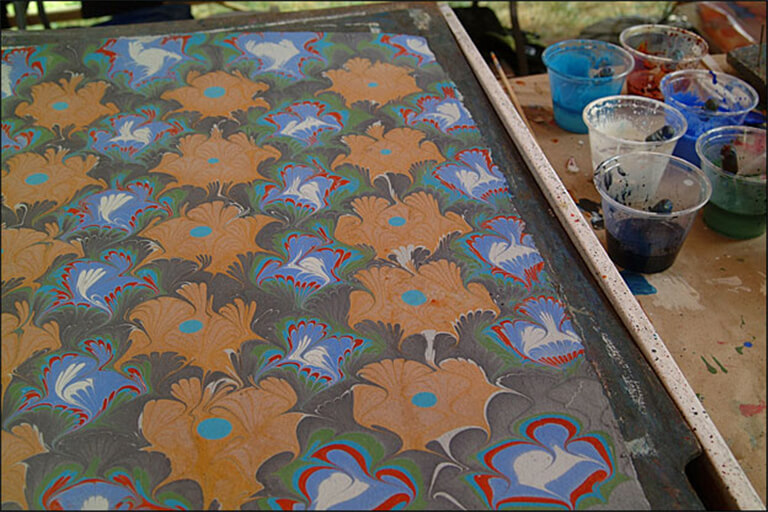Muslim Voices — Marbling

Audio transcript:
0:00:06:>>MANAF BASHIR: Welcome to "Muslim Voices." I'm your host, Manaf Bashir.
0:00:10:(MUSIC PLAYING)
0:00:12:>>MANAF BASHIR: If you open up an antique book and look at its inside cover, you're likely to find the paper there a colorful mix of circles and swirls and lines, more than likely, the result of a technique known as Ebru, or Turkish marbling. It's a technique of transferring color to paper without using a paintbrush and is a difficult art to master. Ihsan Colak is a PhD student at Indiana University. He's also a marbling artist who has spent the last few years developing his skills. He recently led a workshop at the Mathers Museum at Indiana University, where he taught children how to marble.
0:00:53:>>IHSAN COLAK: When I go to the workshops with a lot of people, when I feel nervous, it is - you know, my hand starts being shaky, and you directly see on the art form because it's on the water. It's not on solid thing. So you see that you have to be relaxed. People say that when they do artworks, they feel relaxed after that. But in this art, you have to be relaxed before that because it directly shows on the artwork. Who's next? OK. Oh, she didn't say that she can...
0:01:27:>>UNIDENTIFIED PERSON #1: Lauren...
0:01:27:>>IHSAN COLAK: OK, come this way. I don't think any marbling ebru masters know that - what's going on in this - you know, chemically what's happening because it's on the surface of - there's no oil. It's not oil paint. Normally, oil stays on the water. But it's not oil paint. It's - now I'm using gouache. So it stays on the water. And when you put the paper, paper absorbs all the color. And then when you take it, sometimes I just clean the paper because it has a lot of water on it. You'll see all the color is on the paper and without any mess, any problem, any kind of defect. So you don't know what's going on between paper and water. At least, I don't know (laughter). From this - you know, hold from here. Put your finger here, and then - perfect. Great. Over here, too. And this corner, too. This corner. That's it in full. So take this and go up and down. That's a tough question, actually (laughter) - why I fell in love with it. I had this love of art somewhere in my, you know, life. But I tried music before. I tried - we have ney, the traditional Turkish flute. So I tried that. I couldn't make it. I tried violin (laughter). So that that was difficult too because when I was taking violin courses when I was 27, and I was taking violin courses with 5-years-old children, so (laughter) it was difficult for me to learn the violin as well. And I started playing oud. And I am still learning it - also that. But this visual art is - it's part of your spirit. I mean, I - it's very difficult to explain. It's part of your refinement. When you do this, you feel you're relaxed. You feel you are in some other place other than this world. So that that's why I think I wanted to learn this. OK. I need your help. Take this, hold it like that and bring it - now help me. Help me take it out. Faster. Faster. Now we are done.
0:04:19:>>UNIDENTIFIED PERSON #2: Ooh, pretty.
0:04:20:>>UNIDENTIFIED PERSON #3: Very pretty.
0:04:20:>>UNIDENTIFIED PERSON #2: Can I put it on the table?
0:04:31:>>IHSAN COLAK: Yes. Yeah.
0:04:32:>>UNIDENTIFIED PERSON #3: I like that.
0:04:32:>>: I like it (laughter). The early masters are Sufi sheiks. They used this for part of their Sufi teachings because Sufi teaching has this understanding of defining person religiously, spiritually and in other ways, like with music, with art and other parts of their human development. So now you can - now we are painting everybody. See how colorful I am? Do you see me? This art form is - exists in the United States, but not in public - that they don't - you don't see everywhere in the United States. In some places, there are some Turkish artists coming and going, mostly for the Turkish festivals. But there's some American artists. But they mostly do this for the book art, as a part of book art. And they don't - I haven't seen - there's some, but not very common - the floral design, the flowers. And it's not very common in the United States. And I wanted to introduce this artform.
0:06:00:(MUSIC PLAYING)
0:06:07:>>MANAF BASHIR: Ihsan Colak is a marbling artist and PhD student at Indiana University. This has been "Muslim Voices," a production of Voices and Visions in partnership with WFIU Public Media from Indiana University. Support for Muslim Voices comes from the Social Science Research Council. You can subscribe to our podcast in iTunes or join the discussion on our website. Find us online at muslimvoices.org.


 IU Global
IU Global